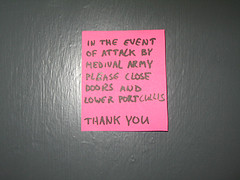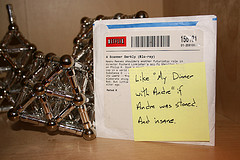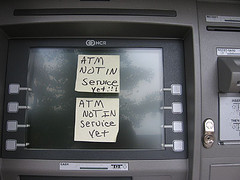[Update: it has been politely pointed out (in the comments following this post) by David Semeria that the Post-it note analogy to FluidDB came from him, not me!]
It’s a pretty simple question, but you may have never thought about it directly. It’s the stickiness of Post-it notes that makes them so extraordinarily useful. The stickiness allows us to put a note in the place that makes the most sense, in the place where its information will be in context, and where it will have the greatest utility.
That’s trivial, agreed, but I nevertheless find it interesting and instructive.
Using Post-it notes we can add information to things in a very wide range of ways. The information might be about the thing to which it’s attached, or the object might just be something we anticipate being encountered at a relevant future moment.
How often do people ask for permission to attach a Post-it note to an object? Probably not very often. I’ve certainly never done it.
The information on the Post-it note can’t be presented by the object the note is on. If the object had been designed to carry that information, there’d be no need for a Post-it note. So Post-it notes are almost by definition for adding information to things in unanticipated ways.
And as for the content of Post-it notes – that’s clearly highly unpredictable. I’ve illustrated this posting with some fun examples.
It’s very useful to be able to put information in its most natural or useful place. We do it all the time. The other day I returned to my apartment and taped to the inside wall of the elevator was a form for the neighbors of my building to enter their gas meter readings. The elevator was the perfect place for the notice. But it certainly wasn’t designed for that purpose. The representative of the gas company didn’t ask permission, they just taped up the form.
I love thinking about how we work with information in the real world – especially the kinds of things we do so frequently or naturally that we barely notice them.
All of which brings me, inevitably, to FluidDB. As I’ve mentioned before several times, FluidDB objects have no owner. That means that anyone can put the digital equivalent of a Post-it onto anything they like, for whatever purpose, without asking for permission, and without anyone having to anticipate that they would want to do so.
That’s all I’ll say for now, as I’m trying to keep this short. I hope it will be thought provoking. Think about how tightly controlled, how unspontaneous, and how awkward our typical computational experiences are. There’s a reason for that, and it’s rooted in information architecture. Think about how Post-it notes, in a simplistic but important way, make the world writable. And then, for extra points, think about FluidDB 🙂
I can’t resist one final image.







